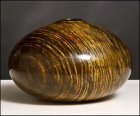Bill, even though I am a relatively new turner, I have played with color on my pieces from the very beginning. In spite of the good natured ribbing I get from the “round and brown” guys in our local club, now almost half of everything I turn has some color. Like Curtiss said, every piece of wood seems to react differently to dyes. That’s why I like using color. You never know what your project will look like, until it is finished. Using color can be challenging and a mystery at the same time.
As Bill B. Mentioned, I also like using Chestnut Stains (that’s the name on the label but they are actually dyes), but I also use Hampshire Sheen Intrinsic colors. Chestnut Stains are alcohol based, vivid, and dry quickly. Intrinsic Colors are water based, have more natural colors, but do take longer to dry. On some “blotchy” woods (pine, birch, and even some maples) the alcohol dyes can give you more consistent results. I personally like the more subdued pallet of Intrinsic Colors. That said, a skillful person can get comparable results from either product.
Now for instruction. I have lost count on the number of videos on coloring that I have watched. My favorite is Martin Sabin-Smith on YouTube. He has several, excellent videos. I highly recommend him. I actually took a class from Jimmy Clewes which was informative and a lot of fun. My dyed rim platter is still sitting on my shelf for all to see. If you really want to get creative and try embellishing along with coloring, Stewart Furini’s YouTube videos are excellent. He is also very entertaining and fun to watch. They are several good books on coloring/dying wood. Just get on Google and you will easily find them. Most focus on flat work but the principles are the same.
You can do a lot or very little with coloring. The possibilities are endless. One last point. Learning coloring is different from learning excellent, technical turning skills, Good turning skills are based on proven techniques and muscle memory (from lots of practice) Coloring is based more on experimentation and creativity. Learning good turning skills can give you predictable results. Learning to color can give many pleasant surprises. Have fun!




